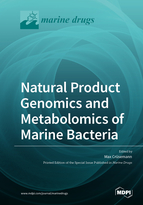Natural Product Genomics and Metabolomics of Marine Bacteria
A special issue of Marine Drugs (ISSN 1660-3397).
Deadline for manuscript submissions: closed (30 July 2021) | Viewed by 48773
Special Issue Editor
Interests: natural products; discovery; biosynthesis; genome mining; metabolomics
Special Issues, Collections and Topics in MDPI journals
Special Issue Information
Dear Colleagues,
Marine organisms are a treasure trove for the discovery of novel natural products, and, thus, marine natural products have been a focus of interest for researchers for decades. Some marine bacteria are prolific producers of natural products, occurring either free-living or, as recently shown, in symbiosis with marine animals.
Recent advances in DNA sequencing have led to an enormous increase in published bacterial genomes and bioinformatics tools to analyze natural product biosynthetic potential by various “genome mining” approaches. Similarly, analytical NMR and MS methods for the characterization and comparison of metabolomes of natural product producers have advanced. Novel interdisciplinary approaches combine genomics and metabolomics data for accelerated and targeted natural product discovery.
This Special Issue invites articles from both genomics- and metabolomics-driven studies on marine bacteria with a focus on natural product discovery and characterization. We particularly welcome articles that combine genomics and metabolomic approaches for the dereplication and characterization of marine bacterial natural products.
Dr. Max Crüsemann
Guest Editor
Manuscript Submission Information
Manuscripts should be submitted online at www.mdpi.com by registering and logging in to this website. Once you are registered, click here to go to the submission form. Manuscripts can be submitted until the deadline. All submissions that pass pre-check are peer-reviewed. Accepted papers will be published continuously in the journal (as soon as accepted) and will be listed together on the special issue website. Research articles, review articles as well as short communications are invited. For planned papers, a title and short abstract (about 100 words) can be sent to the Editorial Office for announcement on this website.
Submitted manuscripts should not have been published previously, nor be under consideration for publication elsewhere (except conference proceedings papers). All manuscripts are thoroughly refereed through a single-blind peer-review process. A guide for authors and other relevant information for submission of manuscripts is available on the Instructions for Authors page. Marine Drugs is an international peer-reviewed open access monthly journal published by MDPI.
Please visit the Instructions for Authors page before submitting a manuscript. The Article Processing Charge (APC) for publication in this open access journal is 2900 CHF (Swiss Francs). Submitted papers should be well formatted and use good English. Authors may use MDPI's English editing service prior to publication or during author revisions.
Keywords
- Natural products
- Marine bacteria
- Genome mining
- Metabolomics
- Structure elucidation
Related Special Issues
- Metabolomics - Applications in Marine Natural Products Chemistry in Marine Drugs (7 articles)
- Microbial Gene Clusters of Marine Origin in Marine Drugs (6 articles)
- Genome Mining and Marine Microbial Natural Products in Marine Drugs (11 articles)
- Genetics of Marine Organisms Associated with Human Health in Marine Drugs (9 articles)
- Bioinformatics of Marine Natural Products in Marine Drugs (7 articles)







